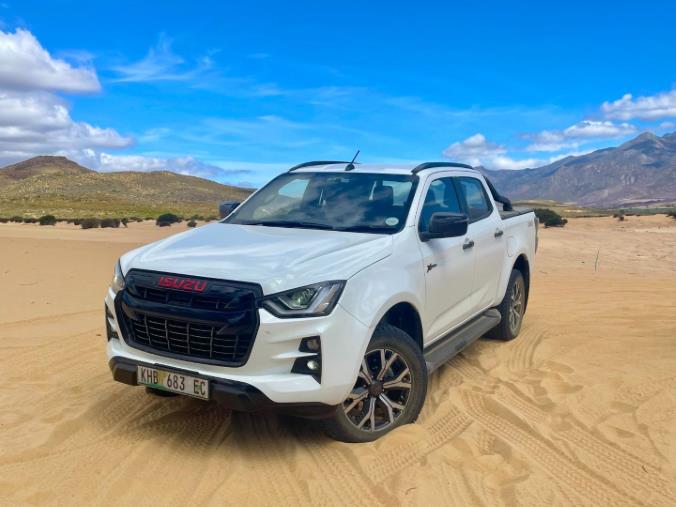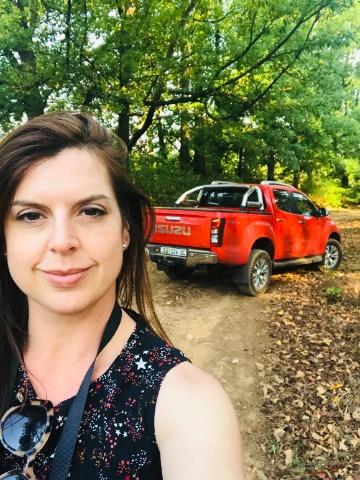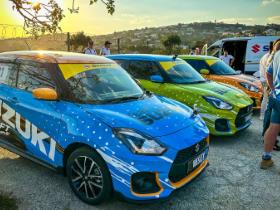In this article:
Styling
Interior, Space, and Practicality
Comfort & Convenience
The Drive and Performance
Fuel Economy
Safety
Price
Competitors
Verdict
The 2024 Isuzu D-Max 1.9TD Double Cab LS X-Rider 4x4 Auto looks so good that we decided it would be the perfect bakkie to accompany us on a few off-road adventures and serve double duty by carpooling the kids to school every day. Did it live up to our expectations?
The X-Rider looks fierce with its blacked-out grille—is it as tough as it looks?
Styling
But first, let's get to its purposeful new look. The rugged-looking X-Rider stands out from the rest of the lineup with its glossy black grille and red Isuzu lettering, X-Rider badges on the front doors and tailgate, black accents, dark grey roof rails, curved sports bar and spiffy 18-inch diamond-cut wheels with red lettering on the centre caps, along with a tow bar (with a 2.1-tonne rating).
Buying used? Read our Isuzu X-Rider Black review from 2019 here.
Based on LS trim, the X-Rider gets the full LED light treatment in the front and rear, including LED fog lamps for excellent visibility no matter the weather.
All specs can be viewed on the X-Rider brochure, here.
Interior, Space, and Practicality
The red and black colour scheme continues on the inside, with red X logos on the headrests and red contrast stitching throughout the cabin. Red/black glossy ombre design inserts adorn the dashboard and the steering wheel is leather-covered with satellite buttons for easy access to infotainment features. The perforated leather seats are very supportive and luxurious to the touch.
The X-Rider is big on storage binnacles and you can safely hide stash a multitude of items. The front central armrest cubby is sizable, and you also have a double-cubbyhole and another lidded storage area on top of the dash, with cupholders aplenty up front.
On the back seat, there is a vast amount of space and the slightly higher, gallery-style seats allow for better visibility for younger passengers. All seatbelts in the back are of the three-point variety and three adult passengers should be able to sit side by side, if the one in the middle is neither too tall nor too wide. Legroom is generous but the central rear passenger will have to put a foot on either side as the floor is slightly raised to accommodate the centre tunnel.
Rear passengers have one USB port and an open storage cubby at their disposal and the rear door bins are not big, but large enough to fit a 1-litre water bottle. The pull-down centre armrest also offers two cupholders. The outer rear seats have easy-to-reach Isofix anchorage points.
There's also a coat hook for the rear left passenger and both seat backs have map pockets where devices can be stored. Overall, the X-Rider offers SUV-like storage solutions where your whole family can happily keep all of their stuff when the need for a long road trip arises. Cleaning out the car pre-shoot made me realise just how much we accumulated over the course of a weekend!
My personal favourite feature (very mom-like, I know) are the easy-to-shake-out rubber mats that fit over the carpeted floor in the front and back. We live in a rural area where dirt and sand get into the car daily, and giving these mats a quick shake made my OCD more manageable.
Comfort & Convenience
The driver's seat is a very comfortable place to be and the ergonomics are top-notch, with all the most important buttons and settings within easy reach. The sporty rev counter and speedometer with elegant silver needles underscore the X-Rider's upmarket ambience, and there's a small colour TFT screen in-between that displays important info, like fuel consumption, range, which axle is engaged, and which door isn't closed properly, for example.
Taking centre stage is a screen that is misleadingly large. Once you turn it on, the smaller 7-inch colour infotainment system touchscreen is revealed. Wireless Android Auto and Apple CarPlay make things nearly hands-free, and the system is Wi-Fi compatible too. It's not the most advanced system but it does the job.
Rear parking sensors and a rear-view camera (without guide lines) are standard fare, and the 6-speaker audio system's sound quality is decent enough.
The three rotary dials underneath the touchscreen facilitate your air-conditioning settings. It's all very straightforward, and in a world that's getting increasingly digital, I welcomed its simplicity. Below that is your 12V power socket, one USB port and another dial where you can shift from 2H to 4H and 4L as needed.
The Drive and Performance
To find out whether Isuzu's 1.9-litre turbodiesel engine (with 110 kW and 350 Nm) truly cuts the mustard, we took it to Klipbokkop 4x4 Academy for a refresher off-road course. On the course with us were a gentleman with his newly acquired Toyota Hilux 2.8 GD-6 4x4 and our instructor in his venerable Toyota Land Cruiser bakkie.

Klipbokkop (near Worcester in the Western Cape) is the place to go if you want PROPER 4x4 training; this is the road that takes you there.
The first section of the course combined insightful off-road theory and technique, but when the practical section started and we pulled into the quarry for a few challenging climbs, we could tell that the Hilux owner was wondering about the capabilities of our X-Rider with its downsized engine, but nothing could hold us back and we traversed every rutted, rocky track with aplomb.

Deep, soft sand like castor sugar? The 1.9-litre X-Rider says, "bring it on!"
When we went rallying through the sand-driving course later on, we felt unstoppable. Our X-Rider didn't flinch for even a split second! We had such fun that we vowed to be back. (If sand driving is your thing, the Atlantis Dunes near Cape Town also offer an almost-limitless playground, and it's here where I made a Toyota Land Cruiser Prado fly.

Hill-Descent Control in action!
As for its manners on tar, it's classic Isuzu: Surefooted, stable, and softly sprung, but never wallowy or uncomfortable, even if you forgot about a certain speed bump. And I love its signature diesel clatter. It may not be as suave as the VW Amarok, but it has so much more of that full-blooded bakkie personality. While it can feel a tad slow when you want to overtake slower traffic, what you gain in fuel economy is worth those few seconds you lose in outright speed.
Driving the kids to school in the dark every morning proved effortless too, thanks to those ultra-bright LED lights I could see very clearly. Usually my other half drives early mornings as my night vision isn't the best, and he was grateful to be able to sleep in for a change.
Are Isuzus good first cars? Find out in this article.
Fuel Economy
Driving mostly in town, fuel economy remained at around 9.3 litres per 100 km, but out on the open, albeit mountainous, road between Hermanus and Worcester, it dropped to around 8. On straight, level roads, you can expect consumption as low as 7.8 litres per 100 km if you drive sensibly. During the Isuzu 1-tank challenge, figures as low as 5.8 litres per 100 km were attained over a distance of 1452 km in the entry-level manual, single and double cab, rear-wheel-drive models (our test model is a 4x4, which is heavier). This translates to Jo'burg to Cape Town on one tank of diesel.
Running cost shootout: Ranger vs Hilux vs D-Max
Safety
The X-Rider comes generously equipped with the usual active safety features, such as ABS brakes, Electronic Brakeforce Distribution (EBD) and Brake Assist (BAS), along with Electronic Stability Control (ESC) with Traction Control, Hill Start Assist (HSA), Hill Descent Control (HDC) and Trailer Sway Control.
(Wondering how much weight the D-Max can carry? Find out here.)

The latest X-Rider has enjoyed a thorough upgrade where safety features are concerned.
Where the X-Rider previously had only two airbags up front, it now has driver and front passenger airbags, front side airbags, curtain airbags and a driver’s knee airbag, bringing the total to seven. This should be a big selling point for parents.
Related: How much is my Isuzu D-Max worth?

ANCAP awarded the Isuzu D-Max a full five stars.
Price
The X-RIDER lineup consists of three models, all in LS spec and available only as a double cab. The 1.9 Ddi D/Cab HR X-RIDER LS (R646 000) features a six-speed manual transmission, while the HR X-RIDER LS AT (R667 100) and 4x4 X-RIDER LS AT (tested in this review at R750 200), come equipped with a smooth six-speed automatic transmission. View the Isuzu South Africa X-Rider microsite here.
Isuzu AT35 D-Max 2023 Launch Report
Competitors
There are so many double cabs to choose from lately, especially cheaper ones fro China in the way of the GWM P Series, and now the LDV T60 range, which kicks off at R480 000. JAC's T9 (from R550 000) could potentially be a threat.
These are five of the best alternatives to the D-Max.
Price wise, the X-Rider in 4x4 auto trim, is not really THAT budget-oriented at present; especially when compared with other stalwarts in the local bakkie scene, like the Mitsubishi Triton 2.4DI-D double cab Xtreme which is slightly cheaper at R728 990. Then, the Ford Ranger 2.0 SiT double cab XLT 4x4 will cost you R732 600 and the Amarok 2.0TDI 125kW double cab Life 4Motion (manual) is priced at 738 300. Then there's the evergreen Toyota Hilux 2.4 GD-6 double cab 4x4 Raider Auto, for a pocket-pleasing (relatively speaking!) R711 400.
Verdict
The X-Rider has long been known for its affordability among leisure bakkies, yet with a range of competitively priced Chinese bakkies entering the market along with other well-established models, Isuzu may face some sales challenges in this segment.
Bearing this in mind, Isuzu still managed to sell 1,202 D-Maxes during April 2024, and is currently SA's third-best-selling bakkie behind the Ford Ranger (2,073 units), and Toyota Hilux in first place with 2094 units. This accounts for all units, of course - Naamsa doesn't differentiate between trim level, double, single and extended cabs. (Read: Isuzu bolsters D-Max range.)
Isuzus are known for their reliability and inexpensive servicing, and the fact that they're locally built at the Struandale plant in the Eastern Cape means that finding parts will never be a problem. Racking up over a million kilos on an Isuzu is also not unheard of; that's why the KB (and now D-Max) is such a hit with local farmers and those in the mining industry. We reckon brand loyalty and proven longevity will be two of the biggest reasons that people continue to buy Isuzu bakkies.
Want to do world-class 4x4 training at Klipbokkop or just get away from it all? Click on the link above.
ENDS


























